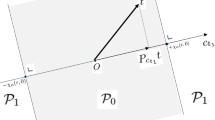Abstract
The propositions and characteristics of the logic-and-probabilistic theory of unsuccess risk with groups of incompatible events were presented, as well as examples of unsuccess risk scenarios and logic and probabilistic models. The problem of identification (training) of the risk logic-and-probabilistic model from the statistical data was stated, and a training algorithm was set forth. Statistical, combinatorial, and logic-and-probabilistic methods of risk analysis were described. High precision and robustness of the logic-and-probabilistic models of unsuccess risk were explained, and in terms of these characteristics the models were compared with other theories of risk and classification of objects. The results obtained can be used for modeling, analysis, and management of risks in complex organizational and technical systems.
Similar content being viewed by others
REFERENCES
Aivazyan, S.I. and Mkhitaryan, V.S., Prikladnaya statistika i osnovy ekonometriki (Applied Statistics and Fundamentals of Econometrics), Moscow: YUNITI, 1998.
Dzhonston, Dzh., Ekonometricheskie metody (Econometrical Methods), Moscow: Statistika, 1980.
Malenvo, E., Statisticheskie metody v ekonometrii (Statistical Methods in Econometric), Moscow: Statistika, 1975, vol. 1; 1976, vol. 2.
Dougherty, C., Introduction to Econometrics, Oxford: Oxford Univ. Press, 1992.
Golberg, A., A Course in Econometrics, Cambridge: Harvard Univ. Press, 1990.
Shiryaev, A.I., Veroyatnost' (Probability), Moscow: Nauka, 1980.
Sharp, W.F., Alexander, G.J., and Bailey, J.V., Fundamentals of Investments, Englewood Cliffs: Prentice Hall, 1993. Translated under the title Investitsii, Moscow: INFRA-M, 1997.
Pervozvanskii, A.A. and Pervozvanskaya, T.N., Finansovyi rynok: raschet i risk (Financial Market: Expectation and Risk), Moscow: INFRA, 1994.
Marshal, Dzh.F. and Bansal, V.K., Finansovaya inzheniriya. Polnoe rukovodstvo po finansovym novovvedeniyam (Finance Engineering. Handbook on Financial Innovations), Moscow: INFRA-M, 1998.
Barone-Adesi, G., Giannopoulos, K., and Vosper, L., VaR without Correlations for Non-Linear Portfolios, J. Futures Markets, 1999, no. 19, pp. 553-602.
Dupacova, J., Portfolio Optimization via Stochastic Programming: Method of Output Analysis, Math. Meth. Oper. Res., 1999, vol. 50, pp. 245-270.
Rockafellar, R.T. and Uryasev, S., Conditional Value-at-Risk for General Loss Distributions, J. Banking Finance, 2002, no. 26.
Kan, Yu.S., Application of the Quantile Optimization to Bond Portfolio Selection, in Stochastic Optimization Techniques. Numerical Methods and Technical Applications, Marti, K., Ed., Berlin: Springer, 2001.
Ryabinin, I.A., Nadezhnost' i bezopasnost' structurno-slozhnykh sistem (Reliability and Safety of Systems of Complex Structure), St. Petersburg: Politekhnika, 2000.
Volik, B.G. and Ryabinin, I.A., Efficiency, Reliability, and Survivability of the Control Systems, Avtom. Telemekh., 1984, no. 12, pp. 151-160.
Ryabinin, I.A., A Suggestion of a New Measure of System Components Importance by Means of a Boolean Difference, Microelectron. Reliability, 1994, vol. 34, no.4, pp. 603-613.
Solozhentsev, E.D., Karasev, V.V., and Solozhentsev, V.E., Logiko-veroyatnostnye modeli riska v bankakh, biznese i kachestve (Logic-and-Probabilistic Risk Models in Banks, Business, and Quality), St. Petersburg: Nauka, 1999.
Solojentsev, E.D. and Karassev, V.V., Risk Logic and Probabilistic Models in Business and Identification of Risk Models, Informatica, 2001, no. 25, pp. 49-55.
Solozhentsev, E.D. and Karasev, V.V., Identification of the Logic-and-Probabilistic Risk Models Systems of Complex Structure, Avtom. Telemekh., 2002, no. 3, pp. 97-113.
Seitz, J. and Stickel, E., Consumer Loan Analysis Using Neural Network. Adaptive Intelligent Systems, Proc. Bankai Workshop, 1992, Brussels, pp. 177-189.
Author information
Authors and Affiliations
Rights and permissions
About this article
Cite this article
Solozhentsev, E.D. Features of the Logic-and-Probabilistic Risk Theory with Groups of Incompatible Events. Automation and Remote Control 64, 1186–1201 (2003). https://doi.org/10.1023/A:1024750605611
Issue Date:
DOI: https://doi.org/10.1023/A:1024750605611




